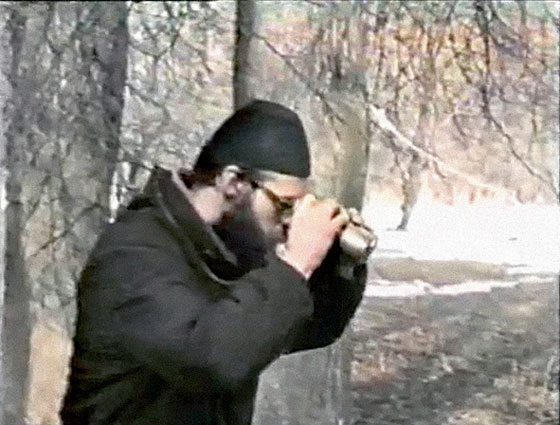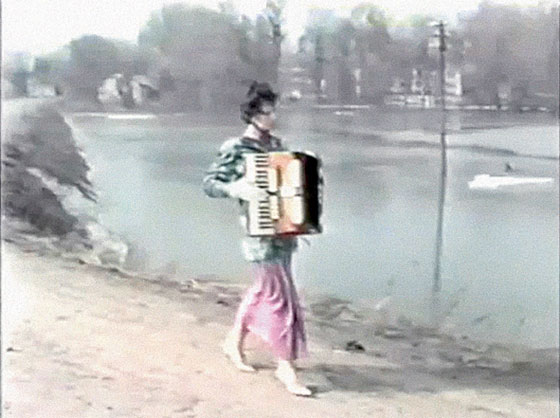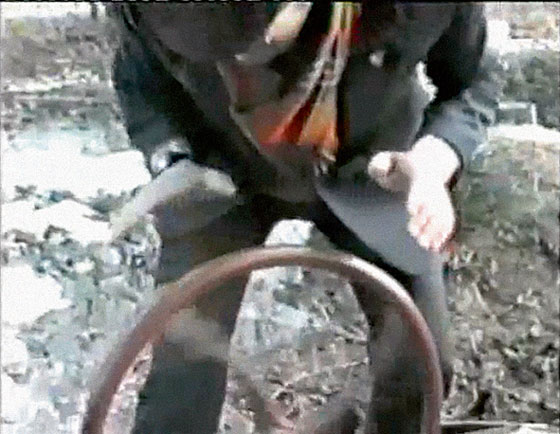|
|
| An open-air minimalist happening Stella Pelše, Art Historian Collection of the Latvian Contemporary Art Museum: Juris Boiko. Spring Grindstone. 1987 | |
 Juris Boiko. Spring Grindstone. Documentation of the happening. Participants: Juris Boiko, Aleksandrs Aksjonovs, Māris Bogustovs, Inguna Černova, Leonīds Codikovs, Niks Ērglis, Dita Piešiņa, Ērika Šmeļkova, Aigars Sparāns, Zigurds Vidiņš (camera, editing). Video full version - 1 h 32' 32". 1987 | |
| Undoubtedly, the most well-known (possibly due to the large number of participants) happenings mounted by the ‘Workshop for the Restoration of Unprecedented Feelings’ (Nebijušu sajūtu restaurācijas darbnīca – the NSRD, founded in 1982) were the legendary walks to Bolderāja. Among other activities by this group of multimedia activists is the video work Spring Grindstone, held in the collection of the Contemporary Art Museum. This is not video art as strictly defined, rather, the medium is more a means for documenting events. “The NSRD expressed its slogan for the video as follows: “SPRING’S GRINDSTONE BREAKS THE SWORD OF WINTER”, and this is one of the very first examples of Latvianvideo art and the NSRD’s “inspired dilettantism”. The spontaneous character and traces of conceptual neo-Dadaism in the open-air happening appear in the video as absurd poetic phrases against the epic background of the natural elements.”(1) | |
 Juris Boiko. Spring Grindstone. Still from documentation of the happening. 1987 | |
| The recording begins with the camera wandering over the melting snowdrifts of spring, water puddles and patterns formed by tree branches in subdued tones subtly reminiscent of the early 20th century paintings of Vilhelms Purvītis and Johans Valters, this time in moving images. Gradually our attention is drawn to a farmhouse in the vicinity of an old manor (this is evidenced by an expressive avenue of trees); people appear and perform all kinds of occasionally random actions – pushing a wheelbarrow, peering through a telescope, turning a grindstone and working with various tools, bashing chunks of ice, writing on a typewriter, making smoke and playing music. Some scenes quite overtly present the liberation motif (untying a bound woman) or escape to the outside (successfully climbing over a fence after several failed attempts), which of course logically tie in with the awakening of nature after the winter freeze but also permit political subtexts, even if these are only in the viewer’s mind. The pauses between the actions are carried by scenes of majestic, contemplative ice flows, providing contrast to the prosaic setting of the happening – mud, puddles, a dilapidated mill. The musical background, which is a very important part of the whole and only occasionally gives way to silence or natural sounds, exhibits a minimalist tendency as the activities of the participants gradually increase, using both traditional instruments (accordion, drums, trumpet) as well as various improvised percussion objects in the spirit of STOMP. | |
 Juris Boiko. Spring Grindstone. Still from documentation of the happening. 1987 | |
| In the final section, the camera glides over chunks of ice floating on water as if they had been filmed from an aircraft, with the sound of the musicians replaced by lapping water. This is followed by something completely different – a concert performed in colourful costumes in a sort of exotic palm house, to conclude by returning to a muddy rural springtime. Again the vibrant ice flows, and a wheelbarrow is pushed along with the commentary [in Russian]: take the souvenir, wheel… these being the only really audible words, which suddenly return us to reality and confirm that this unusual meditative experience has ended. (1) http://videoart.noass.lv/lv/movies/view/271/. /Translator into English: Filips Birzulis/ | |
| go back | |







